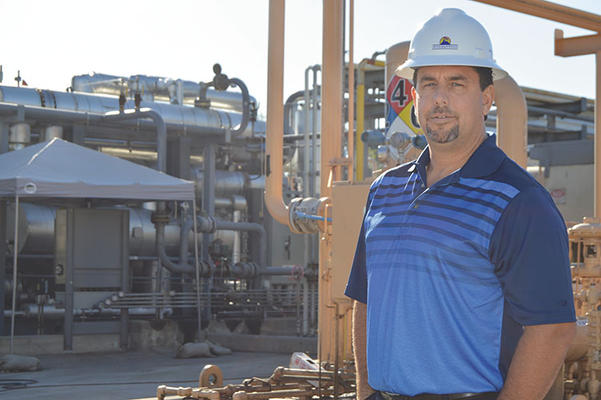The oil and gas industry in California directly supports hundreds of thousands of jobs and is a major producer of tax revenue for local governments and the state. Domestic production here also helps make the state less dependent on foreign energy. But it’s no secret that for the last two years, low oil prices have taken their toll on the industry.
In 2014, the price of a barrel of crude oil began declining from around $100 and, at its lowest point, reached about $26 in January of this year, according to data from the U.S. Energy Information Administration (EIA).

Sean McDaniel is vice president, production operations with Signal Hill Petroleum. Like other oil companies, Signal Hill Petroleum had to adjust its cost structure over the past two years due to low oil prices. (Photograph by the Business Journal’s Larry Duncan)
“It has been difficult for our producers here in California because of the low price of crude oil,” Catherine Reheis-Boyd, president of the Western States Petroleum Association (WSPA), told the Business Journal. WSPA is a nonprofit advocacy organization for the oil and gas industry in the Western United States. “The more robust that price is, it allows our producers more opportunity from an economic standpoint to pursue increasing production in the state,” Reheis-Boyd explained. More production means more jobs and more tax revenue generated for the government, she noted.
The past two years have been “beyond challenging” for oil companies, said Ralph Combs, manager of regulatory, community and government affairs for The Termo Company, a Long Beach-based oil and gas company with operations in nine states. The national oilfield services company Halliburton, for example, has laid off more than 20,000 people since 2014, Combs noted.
Reheis-Boyd said oil and gas companies have been minimizing their operating costs to reduce layoffs. “At some point you have to cut back on labor, and you have to cut back on operations like drilling such that you can remain in existence while you weather the storm,” she said.
Signal Hill Petroleum (SHP), which has operations concentrated in Signal Hill and Long Beach, has “significantly reduced the cost structure of the company,” David Slater, executive vice president and chief operating officer, said. “Whenever we do that, that impacts jobs,” he said.
SHP has reduced its staff from around 140 people to just below 90 employees, Slater estimated. “That’s just tough when we have to eliminate good jobs,” he said. “It affects real people. It affects people that we care about.”
Jobs in the oil and gas industry – which Slater called “one of the last bastions of manufacturing” – are high paying, he pointed out. “Manufacturing forever has been the backbone of really good-paying, full-benefit jobs that you don’t necessarily need a college education for. And you can have a career,” he said. “From my perspective, we have lost way too many of those jobs as a country. I think it’s affecting our whole society as far as . . . what’s happening to the middle class. And my perception is we don’t have enough good jobs.”
The Termo Company didn’t fire anyone, but its employees did suffer income losses. “As to how it affects Termo’s operations and our staffing, we committed to not laying anyone off,” Combs said. “And we managed to do that by everyone on the team sharing the pain of wage and benefit cuts.”
In 2014, Termo’s capital budget was $24 million. This year, it is $6 million, Combs said. “We’ve managed to hold our production steady over the last 18 months with limited capital investment, and so that’s a real important lesson for us going forward,” he said.
Companies that “borrowed too much money to deploy capital, counting on the higher oil prices,” suffered even more, Slater said. “That is a repeat pattern you see in the oil and gas business – [companies] overleverage [and] borrow money to apply technology and drill wells.”
Although SHP has had to reduce its cost structure, an unforeseen benefit of the industry’s downturn has been that the firm has been able to acquire additional wells and reserves from struggling companies, Slater said.
With taxes, Slater estimated about 50% of the price of a barrel of crude oil generated in California winds up as government revenue.
While the low price in oil hasn’t affected the operations of Long Beach Gas & Oil (LBGO), the City of Long Beach’s gas utility and oil operations division, it has impacted city revenues, according to Bob Dowell, director of LBGO. Much of this revenue goes towards the city’s capital projects in its Tidelands areas – coastal parts of the city where oil is extracted.
Last year, the city over budgeted for the price of oil, causing the city council to prioritize its spending on capital projects in the Tidelands zone. With the price per barrel of crude oil currently at about $49, Dowell is comfortable with the city’s fiscal year 2017 budgeted price of oil at $45.
Trends in oil extraction – principally the use of hydraulic fracturing and enhanced extraction methods – caused oil production in the United States to nearly double in the past decade, which contributed to lower oil prices, Slater said. The growing use of 3-D seismic imaging, which allows companies to identify locations in shale formations where oil and gas might be trapped, has also contributed to increased production, he noted.
Reheis-Boyd said oil prices are more impacted by production overseas. “It’s much more impacted by the powers that be within OPEC [Organization of the Petroleum Exporting Countries] and the global conversations going on around crude oil,” she said.
No one knows for sure what’s going to happen with oil prices, but OPEC – which represents oil-producing countries in the Middle East, Africa and South America – will play a major role, according to Slater. “It’s supply and demand. Price has been driven by high supplies,” he said. “So if OPEC does start reducing production, it would strengthen prices. But there’s a lot of what ifs in there, and we are not making any changes in our expenditure plans or cost structure yet.”
Slater said that “noise and information coming out of the marketplace” suggest OPEC may in fact pull back on production. But he said neither he nor his peers have any illusions that the price per barrel will recover to $100 anytime soon.
“I would be surprised to see $60 a barrel before the end of this year, and probably not until mid-2017,” Combs said, adding that he expects the price of oil to stay in the $40-$50 per barrel range this year.
Natural Gas
Natural gas prices experienced an increase from just below $2 per mmbtu (million British thermal units) in early summer to about $3 per mmbtu in July. In the past month, prices have remained just above $3 per mmbtu, according to the EIA.
“There are a lot of wells that were drilled [with] a lot of the newer technology in the shale developments, so reserves of natural gas have grown dramatically over the past four to five years,” Dowell said. “With the decline in prices that happened in 2014, though, drilling has slowed down – if not stopped – in many of the areas because simply the pricing wasn’t there.”
While there is some natural gas production in California, most of it comes from out of state, Dowell noted. California oil companies typically produce natural gas through their operations and either sell it or, in the case of SHP, use it to power their own operations.

Bob Dowell, director of Long Beach Gas & Oil, told the Business Journal that there have been significant job losses in the oil and gas industry over the past two years due to the low price of oil. (Photograph by the Business Journal’s Larry Duncan)
“Natural gas prices are up quite a bit, on a percentage basis, more than oil,” Combs said. “It is picking up nicely, and at the same time, it’s remaining very affordable and allowing the ongoing transition away from coal, which is great.” He added, “We’re starting to add more natural gas to our portfolio.”
The Long Beach City Council recently approved about a 3% increase in gas rates, Dowell said. “When SoCalGas goes in and seeks approval for an increase in their rates, we follow in behind them and do a corresponding request as well,” he said, referring to the Southern California Gas Company, the gas distribution utility serving much of Southern California.
“I think stronger prices help at least develop and identify additional reserves,” Dowell said. “Now the challenges for the industry are building the infrastructure to get it to market and then also improve pricing so that those pipelines will be built.”
Trends Moving Forward
Moving forward, trends in California’s oil and gas industry will be driven by profitability and the need to comply with state regulations, based on observations made by Reheis-Boyd.
Senate Bill 32, an extension of the California Global Warming Solutions Act of 2006 (also known as Assembly Bill 32), set a goal for reducing state greenhouse gas emissions to 40% below 1990 levels by 2030. The legislation did not identify how this would be achieved, nor did it identify associated costs to industry, Reheis-Boyd pointed out.
The legislation also did not address the state’s cap and trade program, which places a cap on allowed greenhouse gas emissions. Companies can purchase permits to allow GHG-producing operations up to a point, the proceeds of which go to fund programs to reduce air emissions and their impacts. If they come in below the cap allowed by their permits, companies may sell or trade the rest in an auction.
But the future of the market-based cap and trade program is in limbo, facing litigation by the California Chamber of Commerce (CalChamber). CalChamber argues that the auction process is a tax and is therefore illegal because taxes must be passed by a two-thirds majority of the state legislature, which it was not.
“So the problem right now is you don’t have a cap and trade program past 2020,” Reheis-Boyd said. “How do you meet a 40% greenhouse gas emission by 2030 with no market mechanism?”
In California, about 38 million residents drive 26 million passenger vehicles and light-duty trucks per year, totaling about 185 billion miles traveled, Reheis-Boyd pointed out. “You’ve got maybe approaching 200,000 electric vehicles that are licensed. And so the gap between 200,000 and 26 million is huge,” she said. “That’s a huge challenge for the state to try to deal with in this kind of time frame.”
To comply with state regulations and remain competitive, oil and gas companies are looking at making the fuels they produce less carbon intensive, Reheis-Boyd said. Viable options include moving toward biodiesel fuels and natural gas, she noted.
Oil and gas companies are also investigating ways to put to use the water they produce. “A lot of what people don’t understand about producing oil in California is we produce a lot of water and a little bit of oil,” Reheis-Boyd said. “For every barrel of oil, we produce 10 barrels of water.”
Signal Hill Petroleum produces about 2.5 million gallons of water every day and recycles that water every day for reuse, Slater said. “We have a massive water recycling program,” he said. “We’re very sustainable, drawing in not a lot of resources from the world but giving a lot of energy back.”
With the state’s drought, there is increased interest in finding other ways to use water from oil production, Reheis-Boyd said. “There is a lot of interest around reclaimed water and agriculture and a lot of interest in working with water districts like the central valley, and how can we safely use reclaimed produced water for irrigation,” she explained.
